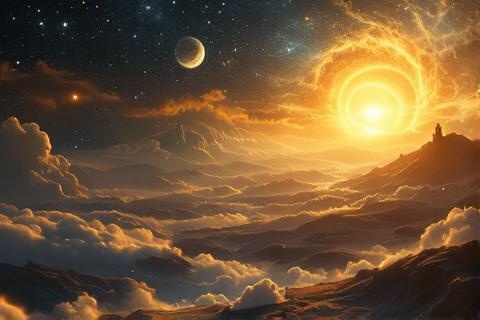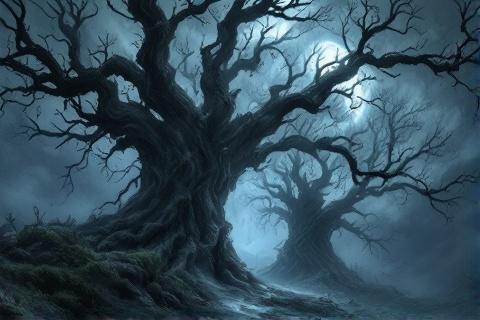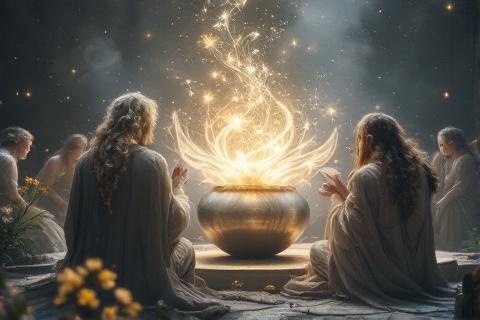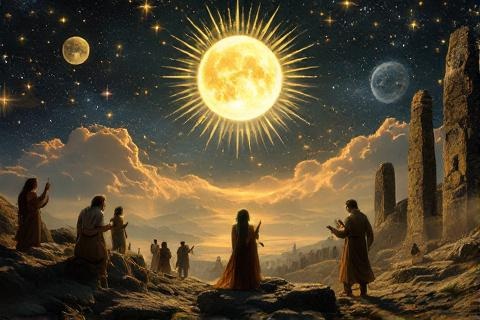
Of the Sun and Moon: The Mythic Dawn of Middle-earth
The Creation of Light and the First Days
The World Before the Sun

In the beginning of Arda, only the stars shone in the heavens, placed there by
Varda, the Queen of the Valar. These stars were created from the
silver dews of Telperion and were the first lights to grace
Middle-earth, providing hope and guidance to the first
awakened Elves at Cuiviénen.
The Two Trees of Valinor brought unprecedented light and
beauty to the Blessed Realm. Laurelin, the Golden Tree, and Telperion, the
Silver Tree, waxed and waned in alternation every twelve hours, mixing their
radiance in brief periods of gentle twilight. Their light blessed the land of
Aman and made it the most beautiful realm in all of Arda.
While the Blessed Realm basked in the light of the Two Trees, the outer lands of
Middle-earth remained in perpetual starlit dusk. This twilight realm was lit
only by the distant gleam of Varda's stars, creating a mysterious and enchanting
atmosphere that would forever remain dear to the hearts of the Elves who first
awakened there.
The Darkening of Valinor

The destruction of the Two Trees came during a time of festival, when
Melkor allied himself with
Ungoliant, a mysterious spirit of darkness and void.
Together they attacked the Trees, with Ungoliant draining their light and life
while Melkor struck them down. The Trees' radiant sap spilled forth and
Ungoliant's poison turned it to ashes in the holy soil of Valinor.
For the first time since their creation, the Trees' light failed and darkness
fell upon the Blessed Realm. The Valar and Eldar found themselves in a blackness
deeper than any they had known, for even the stars were veiled by Ungoliant's
unlight. This darkness brought fear and confusion to the immortal realm that had
never known such absence of light.
In their desperation, the Valar gathered at Máhanaxar, the Ring of Doom, to seek
counsel about this catastrophe. The fate of all Arda hung in the balance as they
debated what could be done to restore light to the world. Their discussions were
urgent and sorrowful, for they knew the Trees' loss would change the world
forever.
During this council, Yavanna, the giver of fruits and creator of the Two Trees,
spoke of a possible salvation. She revealed that if she could receive the last
fruit of Laurelin and the final flower of Telperion, she might be able to revive
the Trees with her power. However, this would require all of her strength, and
even then, the Trees would never shine as brightly as before.
The Last Fruit and Flower
The Valar managed to preserve Telperion's last flower, which gleamed with a soft
silver light reminiscent of the Tree's former glory. This precious blossom
contained the pure essence of Telperion's radiance, unsullied by Ungoliant's
poison, and would become the heart of the Moon.
From Laurelin, they saved a single golden fruit, still burning with the fierce
light of the Golden Tree. This fruit held within it the last pure rays of
Laurelin's magnificence, and would later become the core of the Sun.
These sacred vessels represented the last untainted light of the Two Trees,
carrying forward their essence into a new age. The Valar treated these treasures
with great reverence, knowing they would be crucial in bringing light back to
Arda, though in a different form than before.
The Making of the Moon

Aulë, the great craftsman of the Valar, worked with all his skill to create a
vessel worthy of Telperion's last flower. He fashioned a great globe of
crystalline materials that could contain and magnify the flower's silver light,
making it bright enough to illuminate all of Arda.
For the guidance of this new light, the Valar chose Tilion, a hunter of Oromë's
company. This Maia had long admired Telperion's silver radiance
and begged for this honor. Despite his sometimes wayward nature, his love for
the silver light made him the perfect choice for this task.
When the vessel bearing Telperion's last flower rose into the sky, it became
known as the Moon, or Rána in Quenya. It was the first light to rise in the
darkness after the Trees' destruction, and its appearance brought hope to all
who witnessed it.
The Creation of the Sun

Following the creation of the Moon, Aulë and his most skilled craftsmen labored
to create an even greater vessel for Laurelin's final fruit. This vessel needed
to be stronger and more radiant, as it would contain the more powerful golden
light.
The vessel they created was named Anar, the Fire-golden, and it was designed to
carry the blazing light of Laurelin across the sky. Its craftsmanship surpassed
even that of the Moon-vessel, for it needed to contain and direct much greater
power.
The Valar chose Arien, a powerful Maia who had once tended Laurelin's flames, to
guide the Sun. Unlike Tilion, Arien was a spirit of pure fire who had never
swerved from her appointed path. Her strength was so great that she could endure
the brilliance of Laurelin's fruit without being consumed.
The light of the Sun proved to be far more intense than the Moon's gentle
radiance, just as Laurelin had shone more brightly than Telperion in the days of
the Trees. When Anar first rose, its golden rays reached every corner of Arda,
bringing warmth and revealing both the beauty and the marring of the world.
The First Dawn

The first rising of the Sun occurred in the West, contrary to its later path,
illuminating first the lands of the Blessed Realm. The Valar chose this
direction to honor the light of the Two Trees and as a sign of doom to Morgoth
in the North.
For the first time, true daylight spread across all of Arda, revealing lands
that had dwelt in twilight since their creation. The mountains cast long
shadows, the waters sparkled with golden light, and all of Middle-earth was
transformed by this new radiance.
The new light posed a direct challenge to Morgoth's power, forcing his creatures
to hide from its rays and revealing the extent of his marring of Arda. His
servants retreated into shadows and deep places, though their master's power
remained strong in the North.
This moment marked the true beginning of the First Age of the
Sun. The world entered a new era, one that would see the rise of Men, great
battles against darkness, and the fulfillment of many dooms that had been set in
motion during the Years of the Trees.
The Changing of the World
To establish order in the movements of the new lights, the Valar created the
Gates of Morning in the East, determining that the Sun would rise there and
traverse the sky to the West. This decision reshaped the geography of Arda and
established the familiar pattern of dawn and dusk.
The paths of both the Sun and Moon were carefully planned to ensure regular
cycles of light and darkness across Middle-earth. These paths followed the
ancient track of the Two Trees' light through Ilmen, the region of pure
starlight above the atmosphere.
With the regular movements of Sun and Moon established, the counting of time
began in earnest. Days were measured by the Sun's passage, months by the Moon's
cycles, and years by the complete circuit of seasons marked by the Sun's
journey.
The Dance of Sun and Moon

Tilion, steering the Moon-vessel, proved to be an unpredictable guardian who
would sometimes alter his course to draw nearer to Arien's brighter vessel. His
unreliability in maintaining his appointed path led to variations in the Moon's
speed and position in the sky.
These irregular movements of Tilion created the phases of the Moon, as the
silver vessel's face would appear to change shape throughout its cycle. This
pattern became an important marker of time for the peoples of Middle-earth.
The interaction between sunlight and moonlight created the familiar rhythm of
day, night, and the in-between times of dawn and dusk. These transitions echoed
the mixing of gold and silver light that once occurred between the Two Trees,
though in a less perfect form.
Impact on the Children of Ilúvatar
The Elves, who had awakened under starlight and had known the light of the
Trees, maintained a special affinity for the gentler radiance of the Moon and
stars. They often conducted their festivals and gatherings during starlit
nights, finding beauty in the silver light that reminded them of Telperion.
The race of Men, called the Secondborn of Ilúvatar, awoke at the
first rising of the Sun in Hildórien. This timing forever linked them to the
Sun's light, and they became known as the Children of the Sun, drawing strength
from its rays and ordering their lives by its passage.
The new lights brought unprecedented growth to Middle-earth, as plants and trees
that had lain dormant in the starlight began to flourish under the Sun's warmth.
Forests spread, flowers bloomed, and life proliferated across the lands in ways
never seen during the Years of the Trees.
Legacy in Middle-earth

The movements of the Sun and Moon became the primary means of measuring time
throughout Middle-earth. The Elves, Men, and other races developed sophisticated
calendars based on the cycles of these celestial vessels, though each culture
marked time in slightly different ways.
Different peoples developed their own names and stories for the Sun and Moon.
The Elves preserved the true history in their lore, while Men created various
myths to explain these lights, having awakened after their creation. Some saw
them as vessels, others as divine beings, and still others as objects set in the
sky.
Though the Two Trees were gone, their light continued to shine upon Arda through
their last remnants in the Sun and Moon. This preserved memory of the Trees'
light would continue to influence the history of Middle-earth throughout all its
ages, serving as a reminder of the ancient light that once blessed the world.
